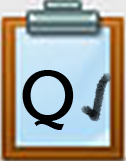Q1 Basics: Student Roadmap
The Roadmap
"How could using the Roadmap help you track your progress and artifacts that you complete as you use these resources?"
Some students and teachers find it helpful to track the different Things and Quests completed during the semester or year. Some school districts use different Things with different core content classes. For example:
- An English teacher might use 4. Suite Tools and 18. Digital Storytelling as part of their course.
- A Technology class might have students complete Things 1-7 in 6th grade, Things 8-14 in 7th grade, and Things 9-21 in 8th grade.
- A math teacher might use 5. Digital Footprint, 13. Dig the Data, 15. Design Thinking and 21 Computational Thinking.
What is it?
 The 21T4S Roadmap is a spreadsheet listing all 21 Things and Quests. It has cells where the Quest completed can be checked off, the date completed, and a column for completed documents such as the portfolio can be linked into it.
The 21T4S Roadmap is a spreadsheet listing all 21 Things and Quests. It has cells where the Quest completed can be checked off, the date completed, and a column for completed documents such as the portfolio can be linked into it.

Where is it located?
21T4S Roadmap 2025-26 is a Google spreadsheet. When it is opened, use the File menu to download it as a Google spreadsheet, Microsoft Excel file, or PDF document. You can copy it to your Google Drive if you are logged into your account.
Competencies & Standards
MITECS Michigan Integrated Technology Competencies for Students
ISTE Standards for Students
1. Empowered Learner
a. Articulate and set personal learning goals, developing strategies leveraging technology to achieve them, and reflect on the learning process itself to improve learning outcomes
Websites and Documents
21t4s Documents




